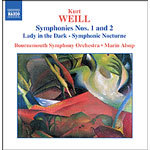
Weill: Symphonies Nos 1 and 2 / Suite - Lady in the Dark
 $25.00
Low Stock
add to cart
$25.00
Low Stock
add to cart
KURT WEILL
Weill: Symphonies Nos 1 and 2 / Suite - Lady in the Dark
Bournemouth Symphony Orchestra, Marin Alsop
[ Naxos / 2 CD ]
Release Date: Wednesday 24 August 2005
Should this item be out of stock at the time of your order, we would expect to be able to supply it to you within 4 - 7 business days.
"A satisfying Second and alluring couplings make this disc a triumph"
(Gramophone Editor's Choice Sept 2005)
EDITOR'S CHOICE GRAMOPHONE MAGAZINE Sept 2005
"An intriguing musical side-glance at Kurt Weill's output. The First Symphony, from 1921, was written at the time when Weill was studying with Busoni. The Second, from 1934, is a much stronger work: it was premiered by Bruno Walter in Amsterdam and is well worth hearing. Marin Alsop and her doughty Bournemouth ensemble play with tremendous spirit, thrillingly recorded."
(MusicWeb Sept 2005)
Five Stars BBC Music Mag (August 2005)
While he left as extensive and as significant an output of stage-works as any composer active during the first half of the twentieth century, the contribution of Kurt Weill to orchestral and instrumental genres was largely restricted to his formative years as a composer from 1918 to 1924. Although he had attempted opera in several unfinished and now lost projects during and after the first World War, Weill's earliest major works are a String Quartet (1918), a Suite for Orchestra (1919) and a Cello Sonata (1920). Yet an urge towards more concrete expression was inevitable in the social climate of post-war Germany, with political left and right fighting for supremacy as the country moved shakily towards a republic. Something of this turmoil can be gauged from the Symphony Weill completed in 1921, but which remained unperformed - and was for many years thought lost or destroyed before being located, surprisingly, in an Italian convent - until 1956.
Until the summer of 1920 Weill held employment as conductor of the opera company at Lüdenscheid, at which time he applied to join the masterclass in composition that Ferruccio Busoni was to direct at the Prussian Academy of Arts in Berlin. The youngest of the applicants, Weill was accepted for a three-year period, starting officially in July 1921, and it is tempting to see this 'First' Symphony as the budding composer's statement of intent. Around this time Weill was approached for incidental music to a drama by the socialist playwright Johannes Becher; though this came to nothing, the play's title, Workers, Peasants and Soldiers: A People's Awakening to God, might almost have been intended for that of the symphony (a quotation from the play was seemingly inscribed on the title-page that Weill later discarded).
Although it plays continuously, the Symphony's single movement is divided into three main sections that together outline, but do not emulate a classical symphonic format. Similarly its tonal orientation avoids a secure key-centre almost as a point of principle. The first section, Allegro vivace, begins with a sequence of grinding, dissonant chords whose tonal ambiguity is to pervade the whole work. The introduction comes to an almost prayerful pause, then a more agitated mood sets in. This allegro-type music has more expressive music as contrast, before the opening chords re-emerge. Anxious elaboration of the ideas ensues, followed by a pensive interlude. This leads into the work's central section, Andante religioso, the spiritual ambience of which is of a distinctly ironic cast. Twice the opening chordal sequence is touched upon, lending an ominous feeling to this otherwise inward-looking music. An earnest chorale-like idea presages the 'Chorale Fantasy' which forms the final section. This builds gradually, by way of a beatific passage for solo strings and wind, to a climax where the opening chords inform a would-be apotheosis. Underlying doubt has not been dispelled, however, and the work ends with a stark, fatalistic cadence.
Tracks:
Symphony No 1.
Symphony No 2.
Lady in the Dark -
Andante misterioso: My Ship
Girl of the moment
Bolero: This Is New
Allegro alla marcia
Dance of the Tumblers
The Saga of Jenny



